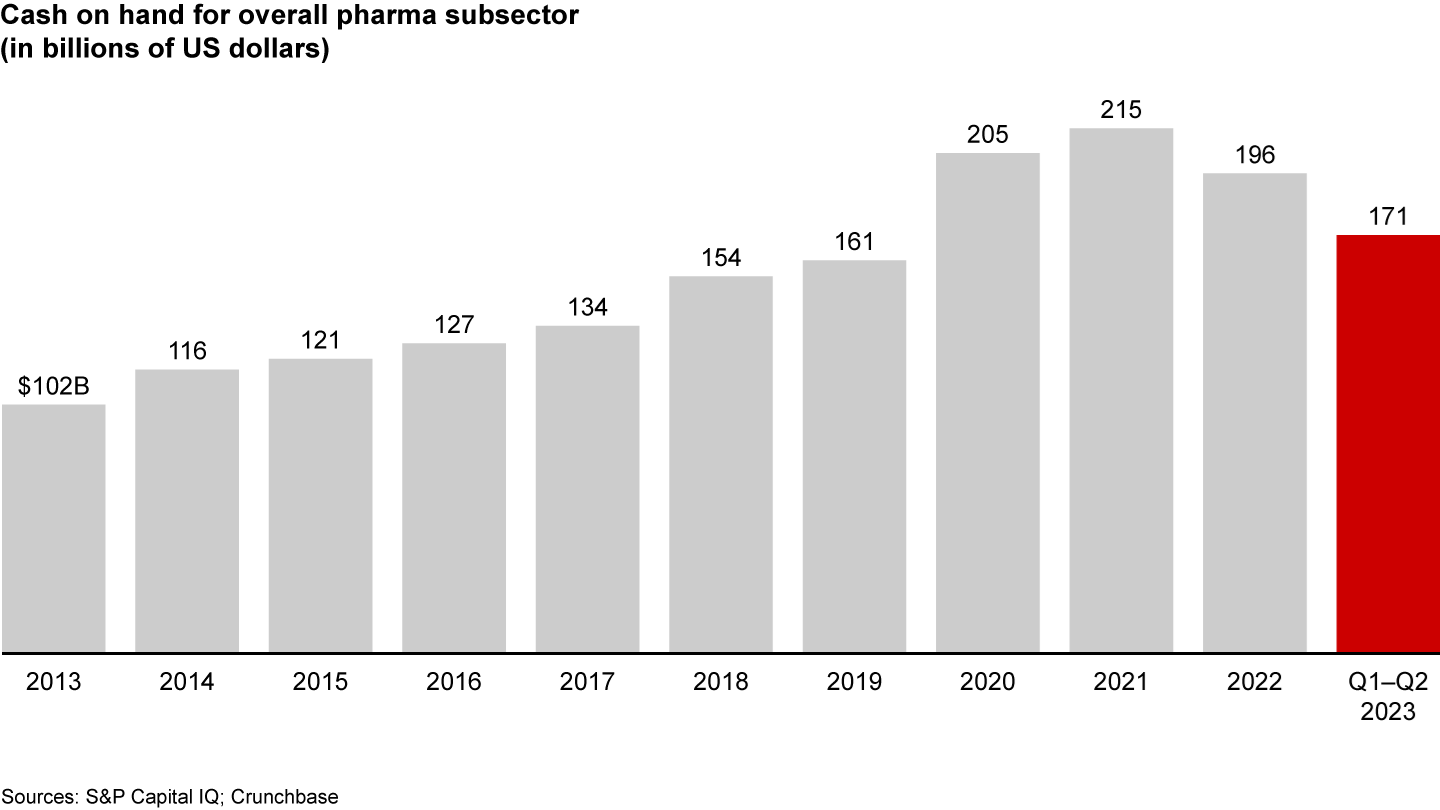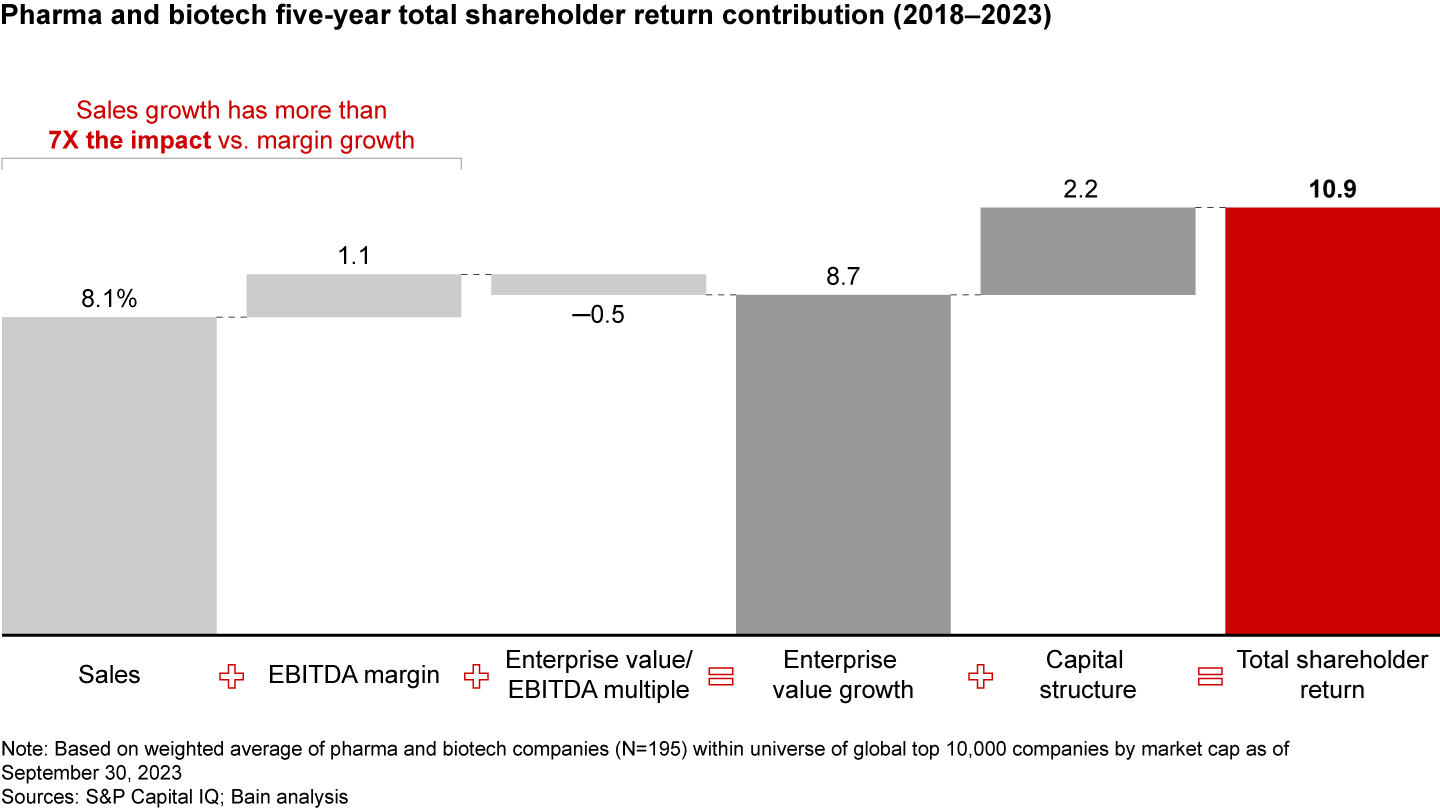M&A Report

At a Glance
- In 2023, deal volume declined across sectors, but deal value rose because of notable megadeals in pharma and medtech.
- Revenue growth is more important than margin growth in healthcare, making M&A an attractive path—and the industry has a lot of cash.
- 80% of healthcare executives surveyed expect to do the same amount or more deals in 2024.
- As the margin for error shrinks, dealmakers must double down on fundamentals to improve their M&A strategy and capability.
This article is part of Bain's 2024 M&A Report.
This year demonstrated that despite high interest rates, regulatory scrutiny, and macroeconomic uncertainty, the healthcare and life sciences industry can’t keep M&A on the back burner for too long. And we anticipate this trend to continue. The industry is sitting on high levels of cash—$171 billion across pharma companies (see Figure 1). Also, top-line growth has a disproportionate impact on total shareholder returns (TSRs) in this industry. In pharma, for example, revenue growth has a seven times greater impact on TSR than margin growth, making inorganic growth especially attractive (see Figure 2). It was not surprising that in our survey of M&A practitioners, 80% of healthcare executives predict that they will do as many or more deals in 2024 than they did in 2023.
Pharma subsector has $171 billion in 2023 cash reserves


Sales growth has had more than seven times the impact on total shareholder returns as margin expansion in pharma and biotech


Unlike many other industries, healthcare saw an overall uptick in 2023 deal value. The pharma and biotech subsector led the way with a 73% leap in deal value despite a 10% drop in volume for the first nine months of the year. On top of that, the year ended with AbbVie making two acquisitions worth a total of $19 billion and Bristol Myers Squibb’s plan to buy Karuna Therapeutics for $14 billion, continuing a new industry tradition of year-end deals.
Deals such as Pfizer’s $45.7 billion purchase of Seagen and Merck’s $11 billion acquisition of Prometheus demonstrated that the megadeal is still alive and kicking, albeit occurring less frequently. We also saw the close of Amgen’s $27.8 billion acquisition of Horizon Therapeutics, a deal that finally made its way through regulatory clearance.
Medtech saw an increase of 36% in deal value despite a reduction in the number of deals during the first three quarters. With the exception of the NuVasive-Globus Medical merger, most of the activity in medtech involved scope deals, such as Abbott’s acquisition of Cardiovascular Systems, aimed at enhancing category growth, filling portfolio gaps, or divesting unproductive assets.
M&A deal activity in payer, provider, and healthcare services continued to stay relatively low. The sector’s most notable deals were led by large payer/healthcare service companies buying providers, such as CVS Health’s purchase of Oak Street Health and the acquisition of Amedisys by United Health’s Optum division.
The focus on scope deals continued, accounting for 89% of the health and life sciences deals during the first three quarters of 2023. It’s a trend that will continue as companies look for assets that can provide them access to disruptive technologies or product category innovation.
As part of their M&A strategy, healthcare companies are looking to divest noncore or underperforming assets. Sixty percent of surveyed M&A practitioners in healthcare and life sciences say that they are evaluating assets to divest. In medtech, recent examples include Baxter’s sale of its biopharma services business and proposed spin-off of its renal business, as well as Medtronic’s separation of its patient monitoring and respiratory interventions businesses.
We have seen more companies spend the year focusing on ways to improve their M&A capabilities. The margin for error has shrunk for getting the anticipated return for any M&A in healthcare and life sciences. Among the biggest challenges is that deal multiples remain relatively high. Mounting efforts to decrease government spending (as in the Inflation Reduction Act in the US) are putting more pressure on future revenue, especially in the areas of healthcare in which the government is a big spender. Regulatory scrutiny is being applied to a broader swath of deals and introducing new risks because of closing delays.
In the year ahead, we expect the following:
- With massive cash volumes on hand, pharma companies will look for innovative assets to acquire in traditional areas, such as oncology and rare diseases, as well as emerging areas, such as weight loss, cell and gene therapies, and precision medicine. While there may be continued demand for biotech targets, such as AbbVie’s recent deals, many other sellers may retain their stance and avoid selling at low valuations despite macroeconomic pressure and lower funding levels.
- In medtech, we anticipate more deals in 2024 aimed at delivering growth, technology access, innovation, and category leadership. Companies will continue to rely on divestitures to optimize portfolios. While companies such as Boston Scientific recently invested in Asia, many others will hold off as they debate what level of investment they should make there and how to gain a manufacturing foothold.
- In payer, provider, and healthcare services, we expect low deal volumes to continue. That said, large payers will continue to leverage M&A for scale or deliver care at a lower cost. In addition, regional providers will pursue deals for scale in primary care, home health, and facility care.
With increasing pressure not only to do deals but to improve the odds that they will deliver the intended results, healthcare and life sciences companies need to focus on improving both their M&A strategy and capabilities. Here’s a checklist for 2024:
- Maintain a deal pipeline, and revise your target lists and deal models in light of interest rates, potential valuation changes, and the emergence of new technologies.
- Invest in disruptive technology. Emerging technologies such as generative AI can fundamentally change your business model. Consider deals to build new capabilities for your organization—and do so before you find yourself lagging competitors. (And know how leading companies are using generative AI to improve their M&A processes.)
- Anticipate the moves that your competitors will make, knowing that some deals have been waiting for years.
- Reevaluate your portfolio with a sharper focus. On the one hand, identify which of your businesses may be better positioned with a new owner. On the other hand, invest to understand the benefits of acquiring for category leadership and the steps to achieving it.
Finally, in this environment of high interest rates and high multiples, corporate diligence and deal execution capabilities will need to be stronger than ever to justify the cost of the deal. Ensure that talent has the capabilities and processes to identify, substantiate, and deliver on synergy goals and other critical deal objectives.